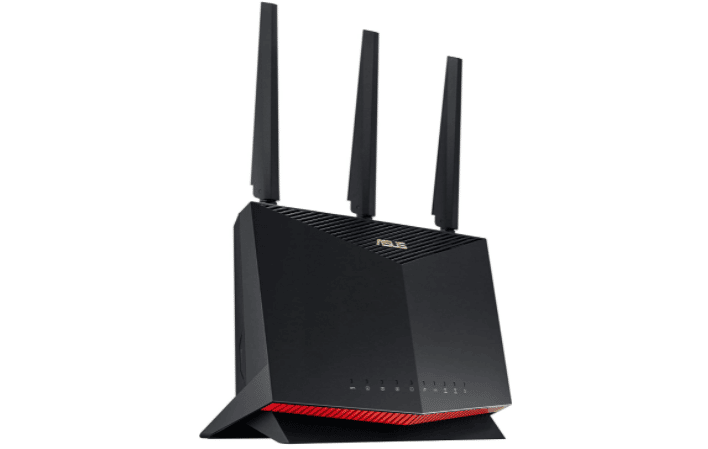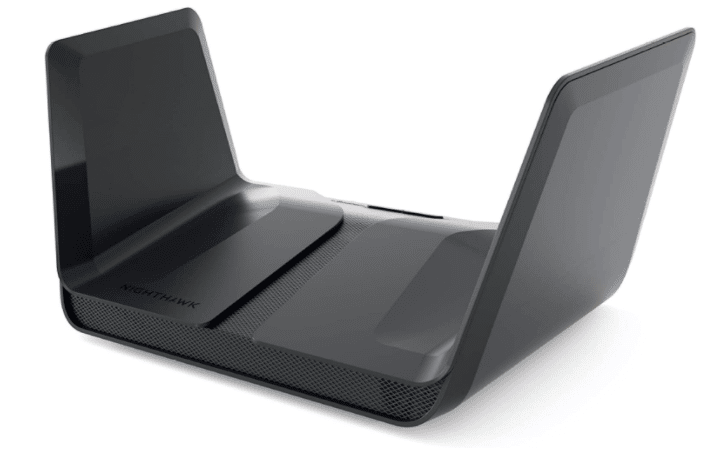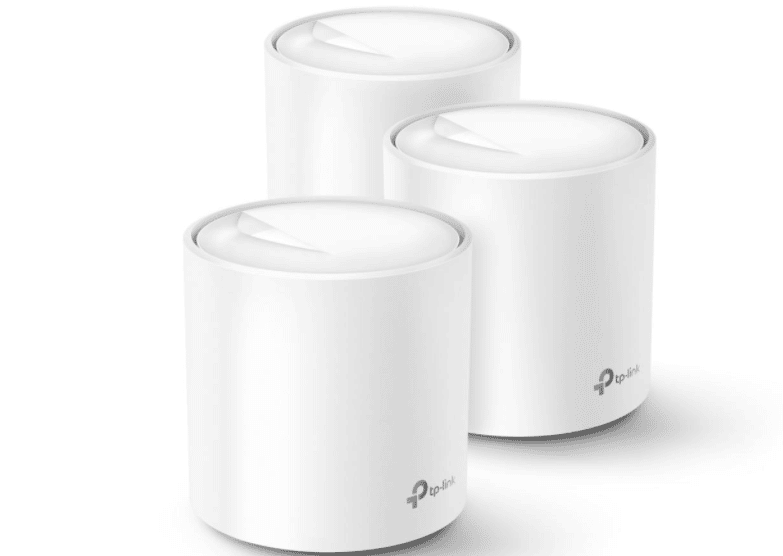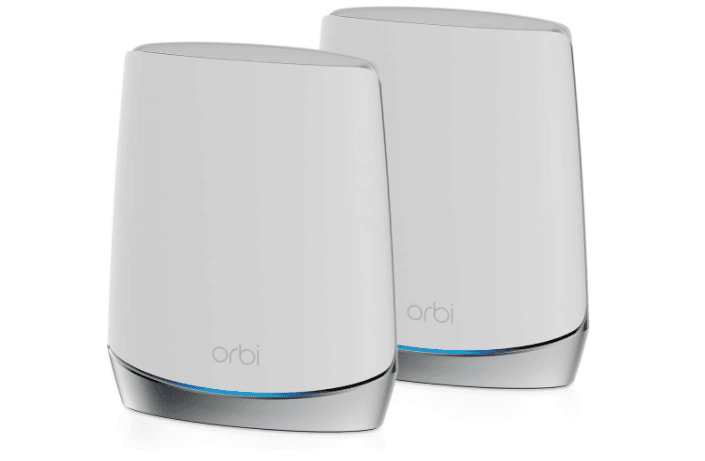When you purchase through links on our site, we may earn an affiliate commission. Here’s how it works.
Best WiFi 6 Router – Overview
Working from home has become the norm. Therefore, you should ensure you have the latest and best internet gear for all your teleconferencing, document sharing, and research needs.
Internet gear and mainly routers have recently undergone massive changes to incorporate technology such as WiFi 6.
So if your current router has served you for at least 3 years and you’re looking to get better speeds, better range, and more security, WiFi 6 got you covered.
You might be wondering then what kind of router you have now, and it’s safe to say most people have a WiFi 5 router or something much older.
Since 2013 when WiFi 5 was first rolled out to the masses, it has been the leading wireless networking standard.
Don’t get me wrong; WiFi 5 is still pretty decent because it has dual-band connectivity, and it can deliver speeds of up to 5.4Gbps. But WiFi 6 blows these numbers out of the water with tri-band connectivity and mind-blowing speeds of up to 9.6Gbps.
There is a lot more to WiFi 6 than just impressive speeds. You also get more connected devices, increased efficiency, improved security, and better battery life in devices connected to your network.
In addition, some of the best WiFi 6 routers are available in a variety of configurations with prices as low as $75 for budget models and over $500 for top-of-the-line models.
You just need to figure out what you need, and you’ll find a WiFi 6 router that’s perfect for you.
So let’s look at what WiFi 6 is, what you should consider when buying a WiFi 6 router, the top WiFi 6 routers available in the market right now, and whether you should upgrade to one of the best WiFi 6 routers or keep your current setup.
What is WiFi 6?
If WiFi 6 is a relatively new term for you, you should understand what this wireless standard entails and why it might be essential for you moving forward. WiFi 6, also known as the 802.11ax, is the next-generation wireless standard.
WiFi 6 is an upgrade on the more popular WiFi 5 wireless standard, also known as 802.11ac, used in most of today’s routers and smart gadgets.
Apart from the expected benefits such as a bump in speed, more connected devices, and better range, WiFi 6 also gives you new capabilities such as the OFDMA (Orthogonal Frequency-Division Multiple Access) protocols.
OFDMA improves thruput by splitting wireless channels into sub-channels and allowing up to 30 devices to connect and use one channel concurrently.
WiFi 6 also improves the size of channels by doubling them from the current 80Mhz to 160Mhz.
This allows for the creation of faster connections between the router and any connected devices. It also allows for broadcasting over vacant frequencies to deliver faster speeds over the 2.4Ghz band.
With WiFi 6, you also get TWT (Target Wake Time), a power-saving feature that allows smart devices to decide when to shift from power-saving mode and begin sending and receiving data.
Devices such as smartphones, tablets, PCs, and even security doorbells and cameras are expected to benefit from this TWT feature.
Other features on the WiFi 6 menu include QoS (Quality of Service) via bandwidth management, WPA3 security protocol, and uplink and downlink MU-MIMO streaming.
WiFi 6 is also very adaptable because recently, the FCC (Federal Communications Commission) partially opened up the 6Ghz band for unrestricted use.
The wireless standard to be used on the 6Ghz band is dubbed WiFi 6E, and it has 1200Mhz of new spectrum and allows for numerous non-overlapping high-speed channels on 80Mhz and 160Mhz.
What Should You Consider When Getting a WiFi 6 Router?
When selecting a WiFi 6 router, try not to make money the primary differentiator and instead think about other reasons why you need to upgrade from your current setup. Some of the considerations you can make, including the price, are:
Speed
WiFi 6 is ideal for high-speed connectivity because this next-gen standard provides more thruput than WiFi 5.
This wireless spec is especially suited to gigabit internet plans which are available in some areas. WiFi 6 will also benefit average internet plans such as 300Mbps since it’s more efficient in sharing bandwidth equally among many connected devices.
The Number of Devices the Router Can Handle
You also need to consider the number of smart devices in your home that need to be connected to WiFi.
Most homes have smartphones, tablets, PCs, and gaming consoles, not to mention Smart TVs, cameras, doorbells, locks, and refrigerators. WiFi 6 allows all these devices to be connected to your network and all of them to receive and send data.
Compatibility
To get the most out of WiFi 6, you need to ensure that you have devices compatible with this wireless spec.
Although WiFi 6 supports backward compatibility and should work with devices that have WiFi 5 or older standards, you won’t get some of its features such as improved range, security, battery life, and efficiency.
For these features to work, both the router and the connected device need to have WiFi 6 built-in.
Range
Another thing you should consider is a range or how far and wide the signal emitted by the router will reach. Some WiFi 6 routers are ideal for smaller spaces such as studios and one-bedroom apartments.
However, if you have a space that’s bigger than 3,000 square feet, you might need a mesh WiFi kit with a base unit and a couple of satellite units that you can place in various points within your house to improve the strength of your connection.
Price
Price is the most significant factor in most people’s shopping decisions.
Although WiFi 6 routers are still more costly than devices using older wireless specs, you can still find several budget options, but there’s no guarantee that they will work as well as their more expensive counterparts.
You’ll note that the range and number of connected devices aren’t at par with the more expensive options. So you need to figure out what you need and go for it.
The 10 Best WiFi 6 Routers Include:
| Best WiFi 6 Routers | Processor | Wireless Speed | Wireless Spec | Antennas | Security Protocols | WAN Ports | Etherent Ports | USB Ports |
|---|---|---|---|---|---|---|---|---|
| TP-Link Archer AX90 | 1.5Ghz Quad-core processor | Up to 6.6Gbps | 802.11ax | 8 (External) | Supports WPA2 and WPA3 | 2 | 3 | 2 |
| Asus RT-AX86U | 1.8Ghz Quad-core processor | Up to 5.7Gbps | 802.11ax | 6 (External) | Supports WPA, WPA2 and WPA3 | 1 | 5 | 2 |
| Netgear Nighthawk RAX80 | 1.8Ghz Quad-core processor | Up to 6.0Gbps | 802.11ac | 8 (External) | Supports WPA2 | 1 | 5 | 2 |
| TP-Link Deco X20 Mesh Wi-Fi Kit | 3x 1Ghz Quad-core processors | Up to 1.8Gbps | 802.11ax | 12 (Internal) | Supports WPA, WPA2 and WPA3 | 1 | 6 | 0 |
| Netgear Orbi RBK752 Mesh Wi-Fi System | 2x 1.4Ghz Quad-core processor | Up to 4.2Gbps | 802.11ax | 6 (Internal) | Supports WPA2 | 1 | 5 | 0 |
| ASUS ROG Rapture AX11000 | 1.8Ghz Quad-core processor | Up to 11Gbps | 802.11ax | 8 (External) | Supports WEP, WPA &WPA2 | 1 | 5 | 2 |
| Linksys MR9600 | 1.8Ghz Quad-core processor | Up to 6.0Gbps | 802.11ax | 4 (External) | Supports WPA2 | 1 | 4 | 2 |
| TP-Link Archer AX73 | 1.5Ghz Tri-core processor | Up to 5.4Gbps | 802.11ax | 6 (External) | Supports WPA2 and WPA3 | 1 | 4 | 1 |
| Netgear Nighthawk XR1000 | 1.5Ghz Tri-core processor | Up to 5.4Gbps | 802.11ax | 4 (External) | Supports WPA2 | 1 | 4 | 1 |
| Linksys Velop Smart Mesh Wi-Fi System | 3x 1.4Ghz Quad-core processor | Up to 4.2Gbps | 802.11ax | 8 (Internal) | Supports WEP & WPA2 | 3 | 9 | 3 |
1. TP-Link Archer AX90

TP-Link Archer AX90
The TP-Link Archer AX90 is one of the first tri-band WiFi 6 routers, and it just about gets everything right. This router features AX6600 speeds, and unlike some other three-band WiFi 6 routers, all bands in the Archer AX90 are WiFi 6.
The speeds breakdown on the AX90 are 574Mbps on the 2.4Ghz band, 4804Mbps on one of the 5Ghz bands owing to its 160Mhz channel, and finally, 1204Mbps on the other 5Ghz band.
Most dual-band WiFi 6 routers can go toe to toe with the AX90 based on speeds alone, but they can’t keep up with its stability in tricky conditions such as a house with plenty of interference or a densely populated building.
TP-Link has also been making advances in the software side of things with its robust HomeCare package.
The HomeCare package includes enhanced security scanning for devices connected to the router and notifications to update you on network activity.
Key Features include:
- 5Ghz Quad-core processor
- Supports wireless speeds of up to 6.6Gbps
- It has the 802.11ax wireless spec
- It has eight external antennas that give it a superb range
- Supports WPA2 and WPA3 security protocols
- 2 Gigabit WAN ports
- 3 Gigabit LAN ports
- 2 USB ports
2. Asus RT-AX86U

Asus
Asus has been able to incorporate plenty of features in the RT-AX86U. This is a WiFi 6 powerhouse with impressive speeds and some killer gaming features.
This router from Asus features AX5700 speeds on a dual-band setup. The speed breakdown on the RT-AX86U is 861Mbps on the 2.4Ghz band and an impressive 4804Mbps on the 160Mhz wide 5Ghz band.
These are great numbers for spaces experiencing a lot of interference.
You also get 2 WAN ports; one of them is a 2.5G WAN port, and the other is a 1.0G WAN port. So if the connection is slower on the 1.0G port, you can switch to the 2.5G port and get better speeds.
The RT-AX86U also has some other incredible bonuses, such as AiMesh, which allows you to connect other routers on your setup to create a mesh system, all with a single WiFi name.
You also Get AiProtection for the device’s lifetime, giving you antivirus protection thanks to advanced parental controls and Trend Micro.
Key Features include:
- 8Ghz Quad-core processor
- Supports wireless speeds of up to 5.7Gbps
- It has the 802.11ax wireless spec
- It has three external antennas that give it a decent range
- Supports WPA, WPA2, and WPA3 security protocols
- 1 Gigabit WAN port
- 5 Gigabit LAN ports
- 2 USB ports
3. Netgear Nighthawk RAX80

Netgear
With the Nighthawk RAX80 from Netgear, you get top performance and enhanced security.
Both these features combine to give you breakneck speeds that smash through the gigabit per second (Gbps) barrier with malware protection and the Disney Circle App meant for enforcing parental controls and managing your network activity.
The breakneck speeds mean that the RAX80 will convey signals over walls and floors. This router may be a bit pricey, just like most WiFi 6 routers, but you get a router that’s easy to set up, allowing you to configure it the way you want.
You also get a 90-foot range in all directions meaning the RAX80 can provide corner-to-corner coverage in a 2000sqft space, ideal for medium-sized homes.
So by virtually any measure, this is a top WiFi 6 router to buy if you don’t want to compromise on safety and performance.
Key Features include:
- 8Ghz Quad-core processor
- Supports wireless speeds of up to 6Gbps
- It has the 802.11ac wireless spec
- It has eight internal antennas that give it a superb range
- Supports WPA2 security protocol
- 1 Gigabit WAN port
- 5 Gigabit LAN ports
- 2 USB ports
4. TP-Link Deco X20 Mesh WiFi Kit

TP-Link Deco
The TP-Link Deco X20 is a relatively cheap mesh WiFi system that can help to fill your home with WiFi 6 connectivity without compromising on your family’s online identities, thanks to its additional layer of security online.
The Deco X20 sells as a 3-pack of identical units: a base router and two towers. This enables this Mesh WiFi kit to provide corner to corner coverage in a 5800 square feet space, making it ideal for a large home.
In addition, the Deco X20 can connect up to 150 devices simultaneously.
With a dual-band setup and two 1.0G Ethernet ports on each tower, the Deco X20 offers you multiple connectivity options with easy setup and management.
With this router, you also get the Deco App meant for TP-Link’s mesh WiFi systems.
The Deco app allows you to quickly set up your network and manage individual features using illustrated and easy-to-navigate menus.
You also get WPA3 security protocol, antivirus protection, and a lifetime subscription to TP-Link’s Homecare security.
Key Features include:
- 3x 1Ghz Quad-core processors
- Supports wireless speeds of up to 1.8Gbps
- It has the 802.11ax wireless spec
- It has 12 internal antennas that give it a superb range
- Supports WPA, WPA2, and WPA3 security protocols
- 1 Gigabit WAN port
- 6 Gigabit LAN ports
- No USB ports
5. Netgear Orbi RBK752 Mesh WiFi System

Orbi
The Netgear Orbi line was one of the first mesh WiFi systems to roll out to the masses, and Netgear has maintained quality from the initial devices up to its latest offering, the RBK752.
This Mesh WiFi kit comes with one base unit and one tower, both with AX4200 speeds.
The speeds breakdown on the RBK752 is 600Mbps on the 2.4Ghz band, 2400Mbps on one of the 5Ghz bands owing to its 160Mhz channel, and 1204Mbps on the other 5Ghz band.
This allows this Mesh WiFi system to provide corner to corner coverage in a 5,000 square feet space ideal for large homes. This router can also connect to more than 60 devices simultaneously without slowing down.
The base unit has three 1.0G Ethernet ports, and the tower has an additional two 1.0G Ethernet ports.
This system also allows you to add an extra tower or satellite unit if you have a space that’s more than the recommended 5,000 square feet limit.
You also get compatibility with the Netgear Orbi App, which lets you set up this system quickly and get regular software and security updates.
In addition, you can use the App to check your network activity and control internet access to all linked devices.
Key Features include:
- 2x 1.4Ghz Quad-core processor
- Supports wireless speeds of up to 4.2Gbps
- It has the 802.11ax wireless spec
- It has six internal antennas that give it a superb range
- Supports WPA2 security protocol
- 1 Gigabit WAN port
- 5 Gigabit LAN ports
- No USB ports
6. ASUS ROG Rapture AX11000

Asus ROG
The Asus ROG Rapture AX11000 is designed to look like a mean machine for hardcore gamers, and for sure, it doesn’t disappoint when it comes to the specs.
This router features AX1100 speeds on a 12-speed tri-band setup. We believe that AX11000 is the best WiFi 6 router out there thanks to its speeds breakdown with 1148Mbps on the 2.4Ghz band, 4804Mbps each on the 5Ghz bands via its 160Mhz channels.
You shouldn’t experience any range issues owing to this router’s eight external antennas. If you need to expand this router’s range, you can do so using AiMesh.
With the AiMesh Software, you can add any other Asus router as a satellite unit to have more coverage in your home.
One interesting feature on the GT-AX11000 is VPN Fusion which allows you to connect this router to a VPN service. With VPN Fusion, game traffic can pass by all while keeping the ping times to a minimum.
Gamers care more about ping times and packet loss than how a router looks most of the time. You also get QoS and full RGB controls on this router. The mean angular design on the AX11000 will look right at home next to your gaming setup.
Key Features include:
- 8Ghz Quad-core processor
- Supports wireless speeds of up to 11Gbps
- It has the 802.11ax wireless spec
- It has eight external antennas that give it a superb range
- Supports WEP, WPA &WPA2 security protocol
- 1 Gigabit WAN port
- 5 Gigabit LAN ports
- 2 USB ports
7. Linksys MR9600

Linksys
The Linksys MR9600 is a WiFi 6 router with a dual-band setup. This is one of the smallest and least conspicuous WiFi 6 routers out there.
Its small size makes it easy to fit this device on most shelves but it leaves little room for numerous ports.
As a result, the Max-Stream MR9600 only has one gigabit WAN port, four gigabit Ethernet ports, and two USB 3.0 ports.
This router can be used as a standalone device or to create a mesh WiFi system by connecting other Linksys routers to it.
Basically, for small and medium-sized homes, the MR9600 can be used solely.
Still, for larger houses of over 5000 square feet, the coverage won’t be so great, so you have the option of connecting other routers to act as satellite units to increase your coverage.
Key Features include:
- 8Ghz Quad-core processor
- Supports wireless speeds of up to 6Gbps
- It has the 802.11ax wireless spec
- It has four external antennas that give it a decent range
- Supports WPA2 security protocol
- 1 Gigabit WAN port
- 4 Gigabit LAN ports
- 2 USB ports
8. TP-Link Archer AX73

Archer AX73
TP-Link’s Archer AX73 is a very capable WiFi 6 router with AX5400 speeds on a dual-band setup. The speed breakdown on the Archer AX73 is 574Mbps on the 2.4Ghz band and an impressive 4804Mbps on the 160Mhz wide 5Ghz band.
Compared to an AX6000 device, this router reduces resources allocated to the weaker 2.4Ghz band and focuses on the stronger 5Ghz band, thereby delivering impressive speeds.
This enables the AX73 to be relatively affordable for most people without compromising on quality.
However, the reduced resource allocation on the 2.4Ghz band means that the AX73 is not best-suited to homes with smart homes with 2.4Ghz devices such as security cameras.
On the back of this router, you get 4 gigabit Ethernet ports and one USB 3.0 port. In addition, this device supports link aggregation amongst the Ethernet ports.
The AX73 has a nice design with plenty of ventilation at the top, allowing passive cooling. The lack of a fan in this router eliminates one potential point of failure.
You also get HomeShield Software, not to be mistaken for HomeCare. HomeShield incorporates most of the same features you find on HomeCare, albeit simplified to a subscription model.
Key Features include:
- 5Ghz tri-core processor
- Supports wireless speeds of up to 5.4Gbps
- It has the 802.11ax wireless spec
- It has six external antennas that give it a decent range
- Supports WPA2 and WPA3 security protocols
- 1 Gigabit WAN port
- 4 Gigabit LAN ports
- 1 USB port
9. Netgear Nighthawk XR1000

Nighthawk XR1000
The Nighthawk XR1000 from Netgear is a powerful WiFi 6 router intended for gamers. However, the speeds on this router exceed those offered by other gaming routers, and you also get top-of-the-line gaming enhancements.
Some of the enhancements include built-in security to provide you with protection against hackers online and a range of 105 feet in all directions meaning this router can cover large spaces of up to 10,000 square feet, making this device ideal for large homes.
The XR1000 also has a full instrument panel of customizable options that you can use to enhance the router’s performance in various ways, such as monitoring CPU usage to see which devices and apps are consuming the most bandwidth, as well as connection tools that allow you to adjust connections by location and ping rates.
So if your current setup isn’t offering you the gaming flexibility you need, consider picking up the XR1000, and you will be impressed.
Key Features include:
- 5Ghz tri-core processor
- Supports wireless speeds of up to 5.4Gbps
- It has the 802.11ax wireless spec
- It has four external antennas that give it a decent range
- Supports WPA2 security protocol
- 1 Gigabit WAN port
- 4 Gigabit LAN ports
- 1 USB port
10. Linksys Velop Smart Mesh WiFi System

Linksys Velop
The Linksys Velop AX4200 is a mesh WiFi 6 system on a tri-band setup. The AX4200 can cover spaces of up to 8,000 square feet with the base router and two satellite units, but if need be, you can have extra satellite units to increase coverage.
This relatively cheap mesh system comes with a generous three-year warranty and has some straightforward configuration tools.
Unlike most other mesh WiFi kits, it also features USB connectivity, a touch that you’ll most likely appreciate.
The AX4200 isn’t the most capable mesh WiFi kit out there, and it lacks the additional customization options and security layers you get in other mesh systems.
But don’t be discouraged just yet; you’re still getting a relatively affordable system that provides corner to corner coverage even in large houses. So this is a WiFi 6 mesh system worth considering.
Key Features include:
- 4Ghz Quad-core processor
- Supports wireless speeds of up to 4.2Gbps
- It has the 802.11ax wireless spec
- It has eight external antennas that give it a superb range
- Supports WEP & WPA2 security protocol
- 3 Gigabit WAN port
- 9 Gigabit LAN ports
- 3 USB ports
Should You Replace Your Existing Router with A WiFi 6 Router?
For most people upgrading to a WiFi 6 router is meant to ensure a seamless connection with their devices over the next couple of years. But that’s not the only reason why you should consider getting a WiFi 6 router.
You’ll be getting a faster connection compared to WiFi 5 routers thanks to the 2.4Ghz and 5Ghz frequency bands.
You’ll also be getting better support if your internet connection is crowded by many connected devices such as smartphones, tablets, and PCs.
WiFi 6 routers are equipped to handle multiple devices better and let’s face it, that’s the situation in most houses today.
With a WiFi 6 router, you can also prioritize which devices get the most bandwidth without limiting all other devices by much.
This can come in handy when gaming because you don’t want any interruption when you’re halfway through an online game.
More devices are being equipped with WiFi 6, so buying a WiFi 6 router now when the market is saturated is better than waiting for when everyone wants one since the price will go up.
Final Thought
To sum it all up, many people are looking to improve the wireless speeds in their homes, and what better way to do that than investing in a WiFi 6 router.
This has seen the price of WiFi 6 routers drop, and you can find these devices at various price points, as illustrated above.
You just need to ensure that you purchase a unit that ticks all the boxes, such as speed, range, ports, and the number of devices connected so that you won’t need to replace the unit soon.